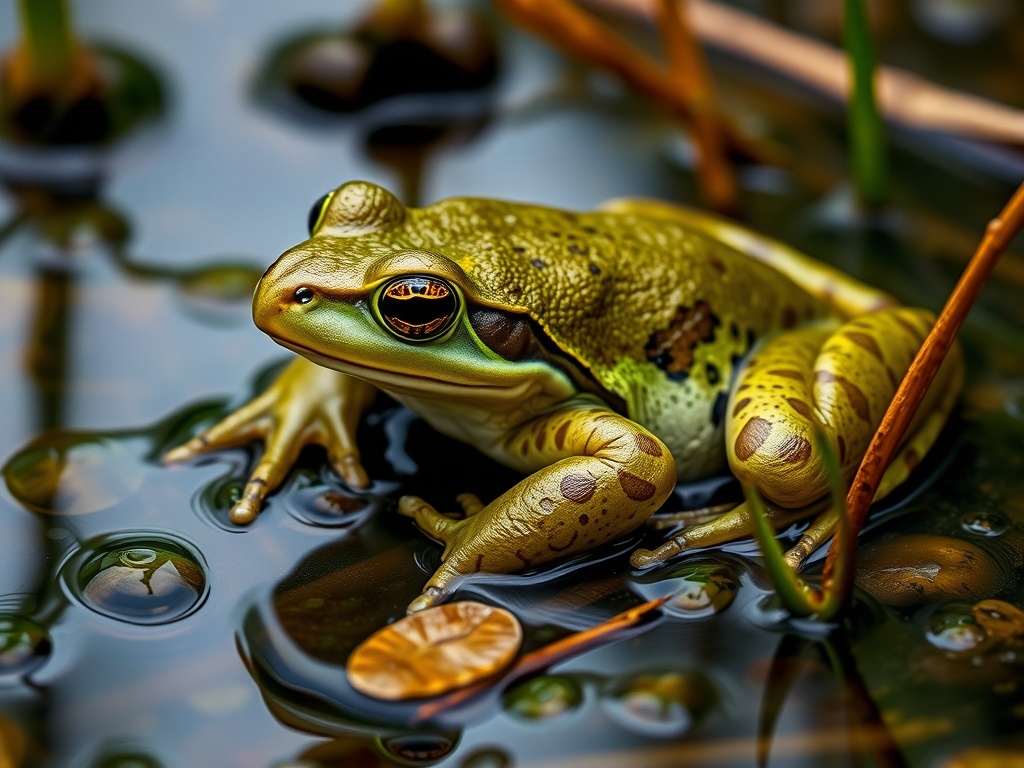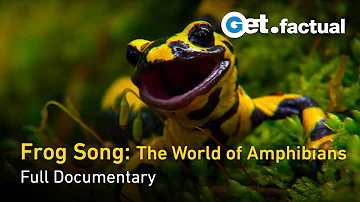
Northern Banjo Frog
Limnodynastes terraereginae

Meet the Northern Banjo Frog
The Northern Banjo Frog is a robust amphibian native to eastern Australia, recognized for its distinctive 'bonk' call that resembles the twang of a banjo. It has a stout body, smooth skin, and is usually brown or gray with reddish patches behind the eyes and on the thighs. This burrowing species spends much of its life underground, emerging after heavy rains to breed in temporary pools and slow-moving waterways. The tadpoles are large and adapted to survive in ephemeral water bodies. Highly adaptable, the Northern Banjo Frog thrives in a variety of habitats, from forests to farmland.
Classification
Amphibian
Habitat
Freshwater wetlands, forests, grasslands, and temporary pools
Diet
Carnivore
Lifespan
5-10 years
Conservation
Least Concern
Weight
25-40 grams
📖Fascinating Facts
Banjo-like Call
The male's mating call is a loud, resonant 'bonk' similar to the sound of a plucked banjo string, which is how the species got its common name.
Expert Burrower
Northern Banjo Frogs use their powerful hind legs to burrow underground, where they avoid harsh weather and predators.
Rain-Triggered Emergence
These frogs remain dormant underground during dry periods and emerge en masse after heavy rainfall to breed in temporary aquatic habitats.
📋Detailed Description
The Northern Banjo Frog (Limnodynastes terraereginae) is a robust, medium-to-large burrowing frog, with adults typically reaching snout-vent lengths of 55–75 mm. Its dorsal coloration is generally brown to olive, often with darker flecks or mottling, providing effective camouflage among leaf litter and soil. A distinctive feature is the vivid red-orange to scarlet coloration on the flanks and thighs, which is most visible when the frog is disturbed or in motion. The species has a prominent dark lateral band running from the snout through the eye to the shoulder, bordered below by a raised cream to orange stripe. The ventral surface is white and granular, while the armpits are marked with orange. Limnodynastes terraereginae possesses a broad, flattened head with a rounded snout and lacks webbing between the fingers, although the toes are partially webbed. The tympanum (external ear) is indistinct. This species is adapted for fossorial life, with strong, muscular hind limbs and a tendency to remain underground for extended periods during dry conditions. Its eyes are positioned dorsolaterally, aiding in vigilance while partially buried. The skin is smooth to slightly granular, and males develop nuptial pads during the breeding season.
💡 Did you know?
Despite spending much of its time hidden underground, the Northern Banjo Frog can rapidly emerge in huge numbers after heavy rains, creating a chorus that fills the night air.
🔬Research & Sources
Wikipedia Summary
The Northern banjo frog is a species of ground-dwelling burrowing frogs native to eastern Queensland and northeastern New South Wales, Australia.
Last Modified: 5/17/2024
🎭Behavior & Social Structure
Northern Banjo Frogs are primarily nocturnal and solitary, spending most of their time underground in self-excavated burrows or utilizing existing cracks in the soil. They exhibit explosive breeding behavior, emerging en masse after heavy rainfall, particularly during the warmer months. Their diet consists mainly of terrestrial invertebrates such as beetles, ants, spiders, and earthworms, which they locate using a sit-and-wait predatory strategy. Foraging typically occurs at night, and they use their sticky tongues to capture prey. Social interactions are limited outside the breeding season, but during breeding, males congregate in temporary pools and call vigorously to attract females. The call is a distinctive, resonant 'bonk' reminiscent of a banjo string being plucked, which can carry over long distances. Territoriality among males is minimal, but they may engage in physical contests if calling sites are limited.
👶Reproduction & Life Cycle
Breeding is closely tied to rainfall and usually occurs from late spring through summer (October to March). Males call from the edges of temporary pools, flooded grasslands, or slow-moving streams. Females are attracted by the calls and select mates based on call quality and location. Amplexus is axillary, with the male grasping the female behind her forelimbs. Females lay large clutches of up to 4,000 eggs, which are deposited in floating foamy masses on the water's surface. The foam provides protection against desiccation and predation. Embryonic development is rapid, with hatching occurring within 2–4 days, depending on temperature. Tadpoles are large (up to 70 mm), darkly pigmented, and adapted to ephemeral aquatic environments, developing quickly to metamorphosis (within 6–8 weeks) to avoid desiccation as pools dry. There is no parental care after egg deposition.
🛡️Adaptations & Survival
Limnodynastes terraereginae exhibits several adaptations for a fossorial and ephemeral aquatic lifestyle. Its powerful hind limbs and pointed snout facilitate efficient burrowing into moist soil, allowing it to avoid desiccation during dry periods. The species can remain dormant underground for months, entering a state of aestivation. The production of foam nests is a key reproductive adaptation, protecting eggs from dehydration and some aquatic predators. Tadpoles have rapid developmental rates and can tolerate low-oxygen conditions in temporary pools. The bright red-orange thigh coloration may serve as a flash display to startle predators. The species' call is adapted for long-distance transmission in open, flooded habitats.
🎨Cultural Significance
The Northern Banjo Frog is well-known in eastern Australia for its distinctive 'bonk' call, which is often associated with the onset of summer rains. The species is sometimes referred to as the 'Scarlet-sided Pobblebonk,' and its calls are a familiar sound in rural and suburban areas. While not prominent in Indigenous mythology, frogs in general hold significance in Aboriginal Australian culture as symbols of rain and fertility. The species is occasionally kept in educational settings to demonstrate amphibian life cycles and adaptations.
🔬Recent Research & Discoveries
Recent research on Limnodynastes terraereginae has focused on its reproductive ecology, particularly the adaptive significance of foam nest construction and rapid larval development. Studies have also examined the species' response to environmental change, including altered hydrological regimes and urban encroachment. Genetic analyses have clarified its relationship to other Limnodynastes species, confirming its distinctiveness and evolutionary history. Ongoing monitoring programs are assessing the impact of chytrid fungus and climate variability on population dynamics. Acoustic studies have explored the role of call structure in mate selection and species recognition.
🎥Wildlife Videos

Eastern Banjo Frog (Limnodynastes dumerilii) - Natural Curiosity
Inspiring passion, appreciation and conservation through wildlife and nature education.
Natural Curiosity

The Purple Frog & Friends: Nature’s Hidden Treasures | Full Documentary
Secret Life Of Frogs In the land of tigers and elephants, deep in the jungles of India, a handful of scientists are at work, trying to ...
Wild Life Documentary

Facts About the Eastern Banjo Frog
Fascinating Facts About the Eastern Banjo Frog | Learn All About the Pobblebonk Welcome to our channel! Join us on a ...
Fun Facts About Animals

Manningham's Backyard Biodiversity: Banjo Frog
It might sound like you have a bluegrass band in your backyard at night, but that's the call of the Banjo Frog. They burrow into our ...
ManninghamCouncil

Frog Song: The World of Amphibians - Full Documentary
Amphibians are living fossils in a modern world. The various species of frogs, toads, and salamanders are more diverse than you ...
Get.factual

Best Of Frogs | Top 5 | BBC Earth
Welcome to BBC EARTH! The world is an amazing place full of stories, beauty and natural wonder. Here you'll find 50 years worth ...
BBC Earth
🌍Habitat Information
The Northern Banjo Frog typically inhabits Freshwater wetlands, forests, grasslands, and temporary pools environments. Northern Banjo Frogs have adapted to their environments with specialized features and behaviors.
Primary Habitat:
Freshwater wetlands, forests, grasslands, and temporary pools
More detailed habitat information will be available soon.
🛡️Conservation Status
The Northern Banjo Frog is currently classified as Least Concern. Conservation efforts are crucial for preserving this species for future generations.
Common Threats:
- 🏠Habitat loss and fragmentation
- 🌡️Climate change impacts
- 🎯Hunting and poaching
- 🏭Human-wildlife conflict
⚠️Threats & Conservation Challenges
Currently assessed as Least Concern by the IUCN, the Northern Banjo Frog maintains stable populations across its range. However, local threats include habitat loss due to urbanization, agriculture, and wetland drainage. The species is susceptible to road mortality during mass breeding migrations. While relatively tolerant of habitat modification, it may be impacted by prolonged droughts and climate change, which reduce the availability of suitable breeding sites. Chytridiomycosis, a fungal disease affecting amphibians worldwide, has been detected in some populations but has not caused significant declines. Invasive predators such as fish and cane toads may pose localized threats to eggs and tadpoles.
🔬Scientific Classification
Scientific Name
Limnodynastes terraereginae
Classification Hierarchy
🔍 About Taxonomic Classification
Taxonomic classification is a hierarchical system used by scientists to classify and organize living organisms based on shared characteristics and evolutionary relationships.
The system moves from broad categories (Kingdom) to increasingly specific ones, with each animal's scientific name typically consisting of its Genus and species.
📝Community Notes
Share your observations and insights about the Northern Banjo Frog with our community of wildlife enthusiasts.
Join Our Community
Sign in to share your observations and connect with fellow wildlife enthusiasts.
Sign In to ContributeNo community notes yet
Be the first to share your observations about the Northern Banjo Frog!
Explore Northern Banjo Frog
Select a tab above to learn more about this amazing animal.
📸Photo Gallery
No photos available for this animal yet.
🌟Discover More Wildlife
Continue your journey of discovery with more fascinating animals from our database
